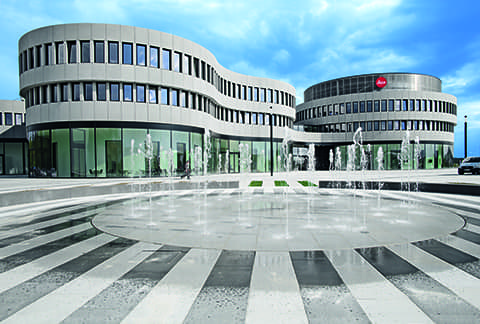Long before the M2 was used to take that iconic photograph, though, it was Leica, rather than its photographers and their subjects, that played a starring role.
Ernst Leitz II, head of the company that went on to become Leica, helped scores of Jewish employees escape the Nazis before the outbreak of the Second World War.
Will Leica launch a full-frame T?

This iconic image of Che Guevara, captured using a Leica M2, will be included in a special Leica auction to be held at Westlicht, Vienna, Austria, tomorrow [Picture credit: Alberto Korda]
It seems fitting, then, that Leica has returned to Leitz’s former home, the picturesque town of Wetzlar in Germany, having left the city in 1986 and spending nearly three decades in an old furniture factory at Solms, a few miles down the road.
Costing €60 million to build, and employing 700 staff, Leitz Park now serves as Leica’s manufacturing and administrative base, much of which is accessible to visitors and customers.
More than 2,000 Leica photographers, dealers and journalists have gathered to witness the official opening, coinciding with 100 years of Leica photography.
The new complex aims to give visitors a behind-the-scenes look at Leica’s cameras, lenses and sports optics, in a medieval town that grew from its prime location on the old trade route from Frankfurt to Cologne and Antwerp, on the banks of the River Lahn.
With roots that stretch back to the 8th century, Wetzlar has held close links with the optics industry for more than 160 years. In 1849, Karl Kellner founded the ‘Optics Institute’, which was later taken over by Ernst Leitz.
New beginning
Fast forward to May 2014 and Leica bosses are in their element, so to speak, at a press conference to mark the official opening of Leitz Park.
Today they hailed the homecoming as a ‘new beginning’, transforming the brand into a ‘tangible experience’ that kicks off with an Open Day for the public on Saturday 24 May.
Dr Andreas Kaufmann, chairman of Leica Camera AG, said: ‘No other brand has so crucially shaped and influenced the past 100 years of photography like Leica, by continuing to provide photographers with the best tool and superb lenses to match…’
Dr Kaufmann, who owns most of Leica Camera AG through his investment firm ACM, added: ‘The Leitz Camera set out from Wetzlar to conquer the world. Now that Leica Camera AG is returning to its birthplace, we are underlining the immense importance that the city possesses for the entire optical segment in Germany.
‘Leica Camera AG is returning to… a new home that is open to visitors and photography enthusiasts and offers them a unique experience with valuable insights into the past, present and future of photography.’

Oskar Barnack
Leica wasted no time in informing guests that Wetzlar is where, around a century ago, Oskar Barnack invented and constructed the first still-picture camera for 35mm cine film (using a 24x36mm negative format), laying the ‘foundation stone for the commercial success of the Leica 35mm camera’.
It was an innovation that ‘irrevocably changed the world of photography and paved the way for countless classic, spectacular, historic and earth-shattering photographs,’ the firm adds.
Leica promises a range of attractions for photography enthusiasts – not just dedicated Leica fans – in the 27,000 square metre space that also houses the firm’s customer care divisions and Leica [educational] Akademie.
Open Day visitors can expect a series of exhibitions of ‘photography through the ages’, to include masterpieces from a century of Leica photography, alongside contemporary work.
Leitz Park also offers ‘openly visible’ production areas, a Leica experience zone, a gallery, photo studio, restaurant and coffee house.

The ‘Leica experience’ room will give visitors the chance to view the ‘clean rooms’, where lens elements, complete lenses and camera bodies are made.
Window panes will double as touchscreens to enable visitors to access films, photos and more, interactively. Not surprisingly, perhaps, there will also be the chance to buy Leica products.
Leica CEO Alfred Schopf added: ‘It was our intention to create not only a place where our cameras, lenses and sports optics are made, but also a place that visibly expresses the values of our brand.
‘The Leitz park celebrates the Leica legend in many ways – be it in exhibitions of photography, the Leica experience or in a look-behind-the-scenes of the production process.
‘We expect to see tens [of] thousands of visitors every year, many of them from abroad – after all, Frankfurt airport is only 60km from here.’
The plant aims to be energy-efficient too, boasting ‘geothermal energy collectors’ under the car park, for example, to help power much of its energy needs.
Fresh from the launch of the Leica T – the firm’s first consumer-level compact system camera – things appear distinctly more rosy, business-wise, for the company than it did five years ago, when Leica, famed for its ‘red dot’ logo, was in the red, financially speaking.
However, not all Leica’s products will be made in Wetzlar. While the new Leica T compact system camera is engineered in Germany, as we reported a month ago, the camera is hand-polished at a factory in Portugal and the lenses are made in Japan.
City of optics
Affectionately dubbed the ‘city of optics’, Leica’s birthplace lies in the state of Hesse. Precision lens maker Carl Zeiss Sports Optics also has ties to Wetzlar – stemming from Moritz Hensoldt’s move to the city in 1865, when he opened a workshop making optics for telescopes, astronomical equipment and microscopes.
The opening of two train lines in 1862/63 had served to boost the city’s international connections, expanding sales and access to raw materials, and led optics manufacturing to become a key employer in the region.
More follows…







